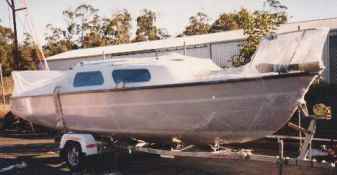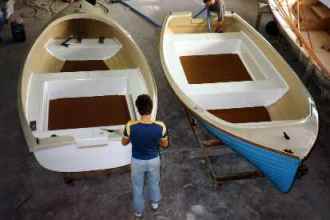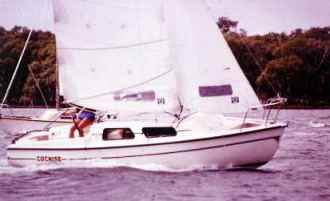During the 1960s, Alan Payne was a measurer for the NSW Flying Dutchman Association and also was involved in the designing and building of the 12Metre America’s Cup boat “Gretel”.
Alan had invited me up to see “Gretel” being built in Halverson’s yard in Sydney. I was very interested and although I couldn’t afford to go at that time, I vowed that one day we would go and see the cup won.
Twenty years passed all too quickly and now in 1983 with “Australia II” I had the feeling that it was now or never. There were so many people involved that we had been associated with previously. John Bertram came from Chelsea, just down the road from where we had built boats in Frankston. Mike Fletcher, the coach, had made our first casting patterns, and sailed one of our Flying Dutchman, and we had built a boat for Bob Miller, now calling himself Ben Lexen (the designer of Australia II).
And it was obvious that Alan Bond wanted to win at any cost!
June and I were fortunate to join a group from Royal Queensland Yacht Squadron and the result of the race is now history! It is enough to say that it was so exciting that we hardly slept for the month at Newport.
In New York on the way home, I asked a taxi driver what he thought about America losing the “America’s Cup”. His reply, “I don’t care about golf.”
There was no doubt about the organising ability of Alan Bond and the skill and seamanship of the Australian crew, but I still have doubts as to any benefits at all of winged keels. I felt that it was crew work and tactics, and that this time the Americans weren’t allowed to win the war of words. Plus in the deciding race, a little bit of LUCK.
The negative effect of the whole campaign was the huge amount of publicity given to cost. A new headsail every second race $20,000.
Replacing a torn spinnaker $50,000 and they already had 5 on hand.
The cost of the whole campaign was $50,000,000.
These figures to me seemed quite crazy, but to the families at home who were seriously thinking of taking up sailing and didn’t know better, it was all quite frightening. Some people that I had talked to before leaving, who were interested in taking up sailing as a family pastime, were of the mind that they wouldn’t be able to afford the ongoing costs of owning a sailing boat. Wives in particular were concerned about it so the families turned to some other activity.
On top of the negative effect of the Americas Cup, Australia moved in to an economic downturn. To cap it all off, the New Zealand government created an export bonus of 20%, and that meant that boats built in that country could be sold here at close to cost price.
There was a scam going on with one particular New Zealand boat building company, where they suggested to potential purchasers that instead of the usual deposit, they bring over some gold bullion. Then when the boat was shipped and arrived at the Australian port, only the final payment would show on the invoice . Customs would then only collect the 20% sales tax on that amount. Quite a saving!
I got quite upset with this going on and went up to the Sales tax office to complain. They did take it up with customs but were told to mind their own business. Fortunately it was all soon stopped.

The boats for Japan were shrink wrapped in plastic and shipped in a
side loading container.
When they arrived in Japan they had to have
special permission to be trailed to their destination
as trailers are
not allowed.
We received a letter from the Australian consulate in Japan indicating that there was interest in the RL24 over there, and we did receive some orders through them. It seemed strange that the most important issue was colour. These boats had to be a particular shade of pink!
Japan is a difficult market for sailing boats as the commercial fishing industry is very influential, and there are only small parts of the coastline set aside for pleasure boating. It is very expensive to have a boat in a marina. Trailer boats are out as there are few places to launch, and boats on trailers are not allowed on the road without special permits.
Queensland was having a lot of trouble with the electricity supply due to constant strikes. Then when the government sacked all concerned, there was no power. So to overcome the problem we dragged our big compressor outside, bought an old Volkswagen, jacked up the rear wheels, took a tyre off and connected a belt to the compressor. Then along with a lot of air tools, we were back in business.
About half of the builders of yachts disappeared over the next three years due to the recession, and we took on some new projects to try and keep our staff intact.

One of the new projects we took on was these 15ft traditional clinker
style fishing dinghies, And yes, of course I did set up some as
sailing boats, and they sailed quite well.
During the downturn I had some time on my hands to experiment with different rigs on the 24, and tried to get the maximum efficiency within the rules. The idea was to create a sail with the longest luff measurement possible, along with the most effective mainsail to headsail ratio.
Theoretically the longer the leading edge in a sail in relation to its area the more lift it will develop (that is why gliders have such long and slender wings). Also it is an advantage to block off the ends of a sail to prevent the air leaking back to the leeward low pressure side. Several problems soon became apparent. How do you fit a vang if the boom is down at deck level? And how to control the shape of the sail.
Finally I came up with a sail similar to a wind surfer!

To windward the rig was very effective. The wishbone tension
allowed good control of
shape, and the high aspect, close sheeted
headsail allowed us to sail very high
without the main back winding.
It was definitely superior to windward, and at
times the boat felt like
it could plane to windward.
To windward the boat performed well but off the wind, because of the wishbone, the sail could not be let off far enough to be effective, so we were forced to do a lot of down wind tacking.
I felt that this rig could be quite effective in an out-and-out racing boat, but didn’t consider it really suitable for the 24s, as it involved quite a few extra control lines, and to get maximum performance it required constant adjustment. Not ideal for a family boat.
I had designed an out-and-out 25 ft racing boat, and would try the rig on that at a later time.